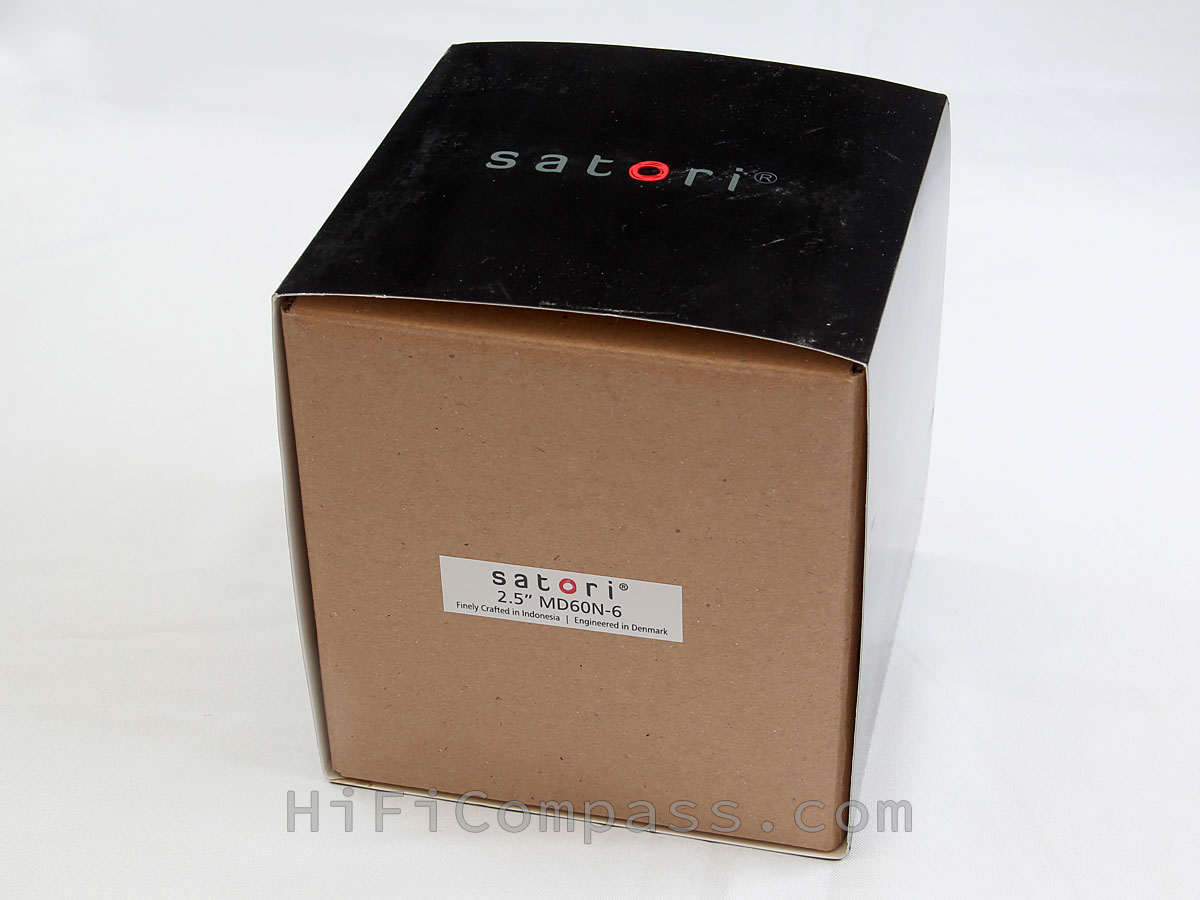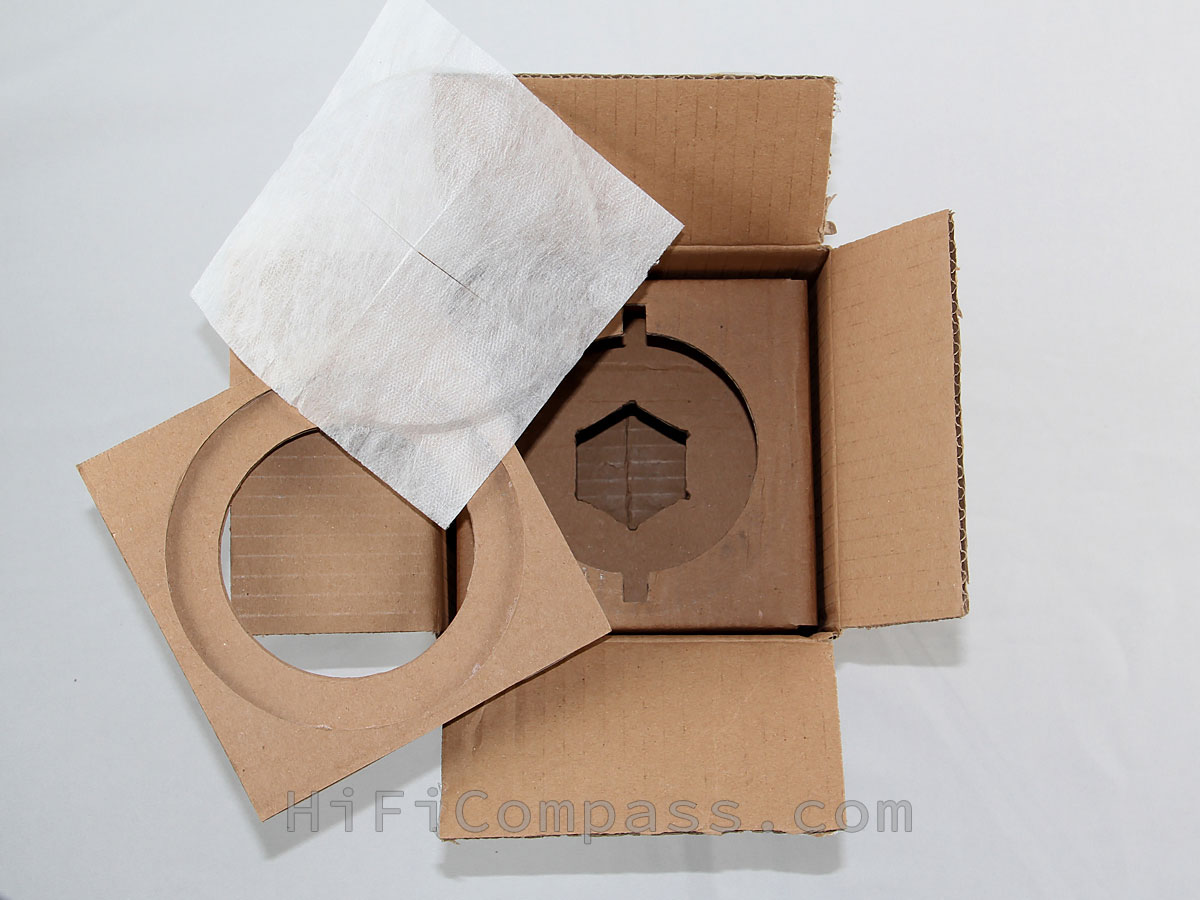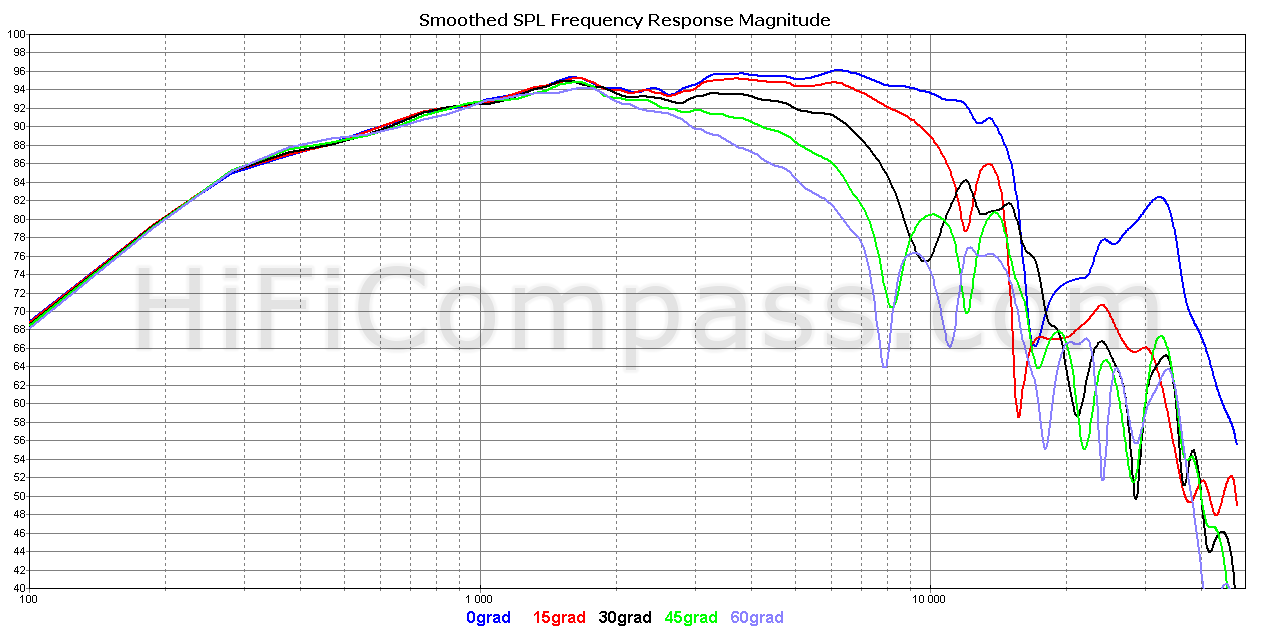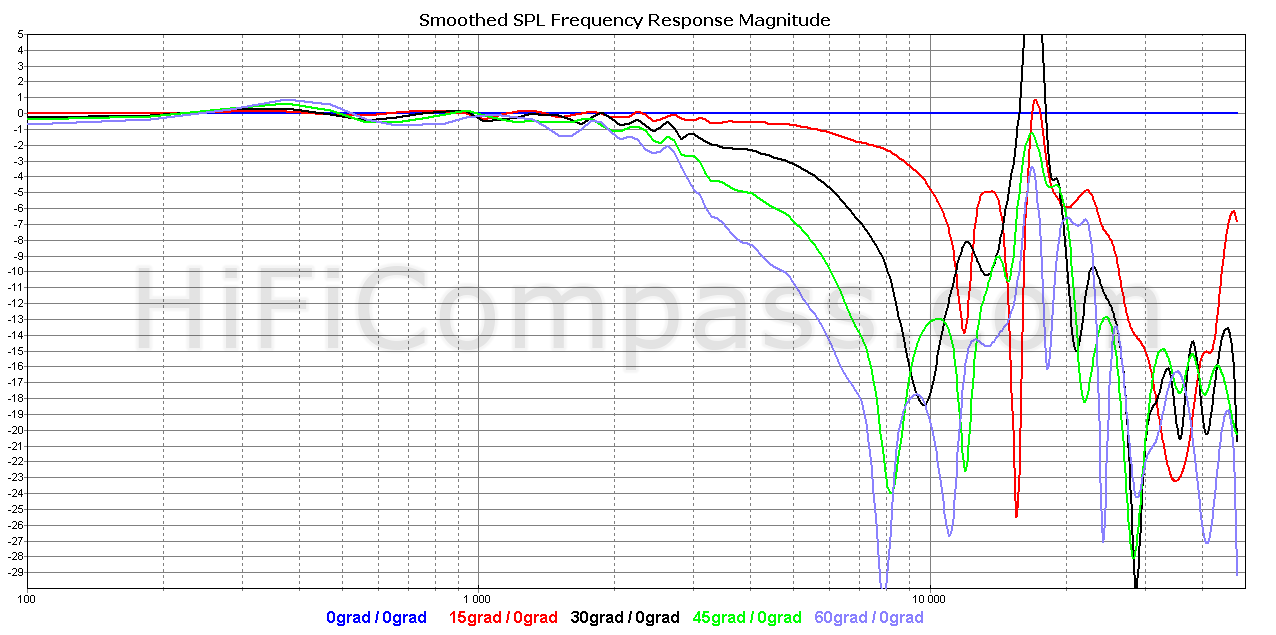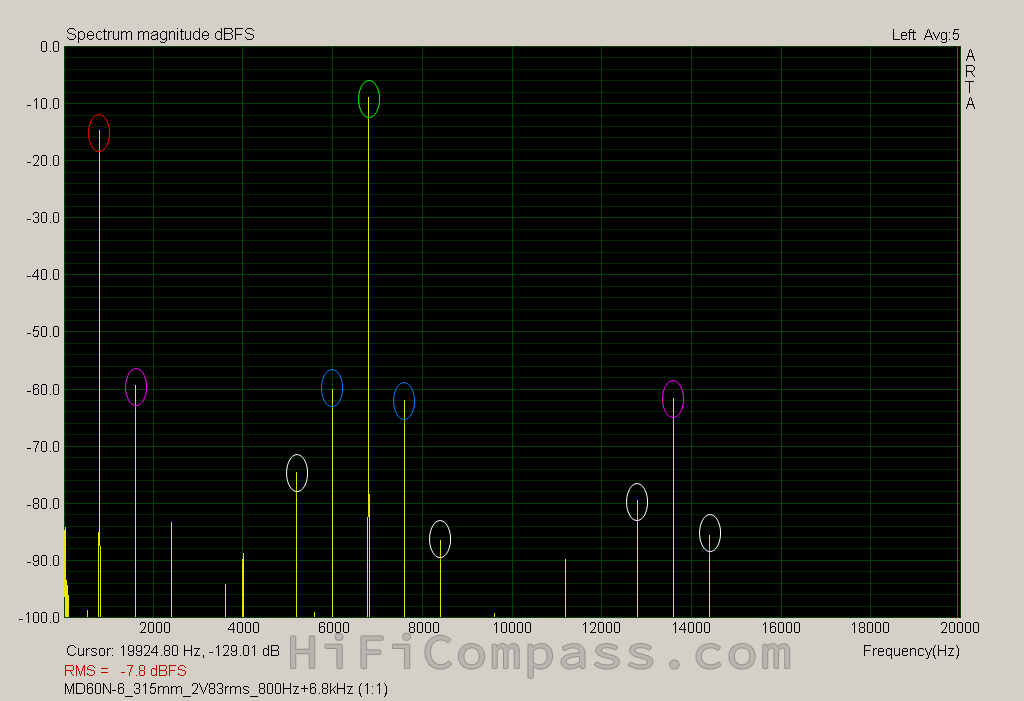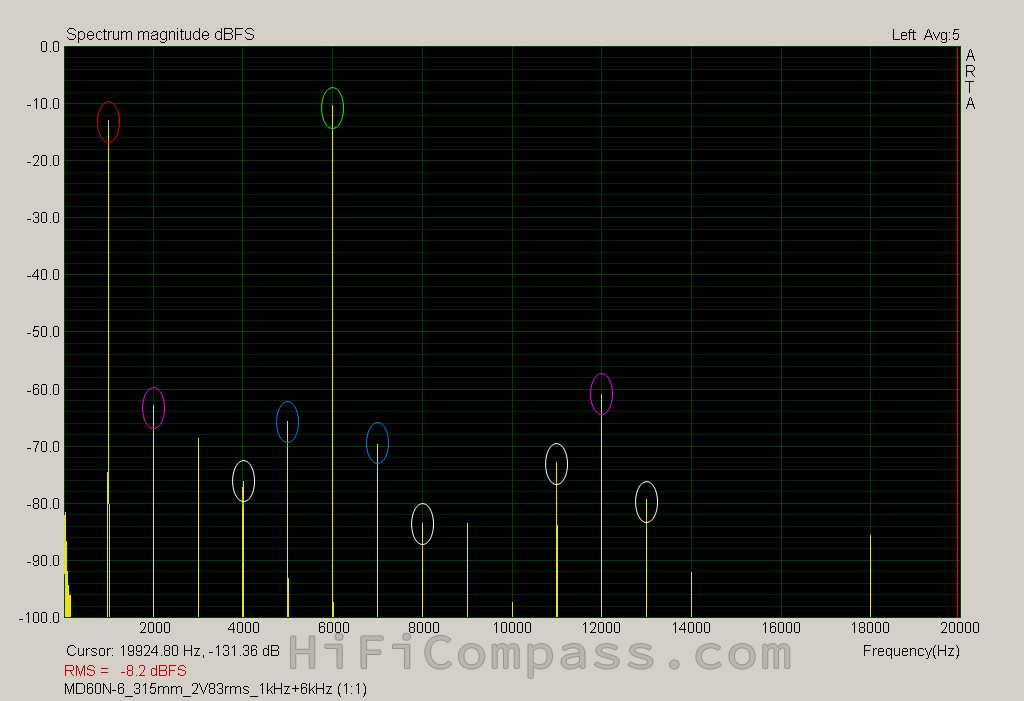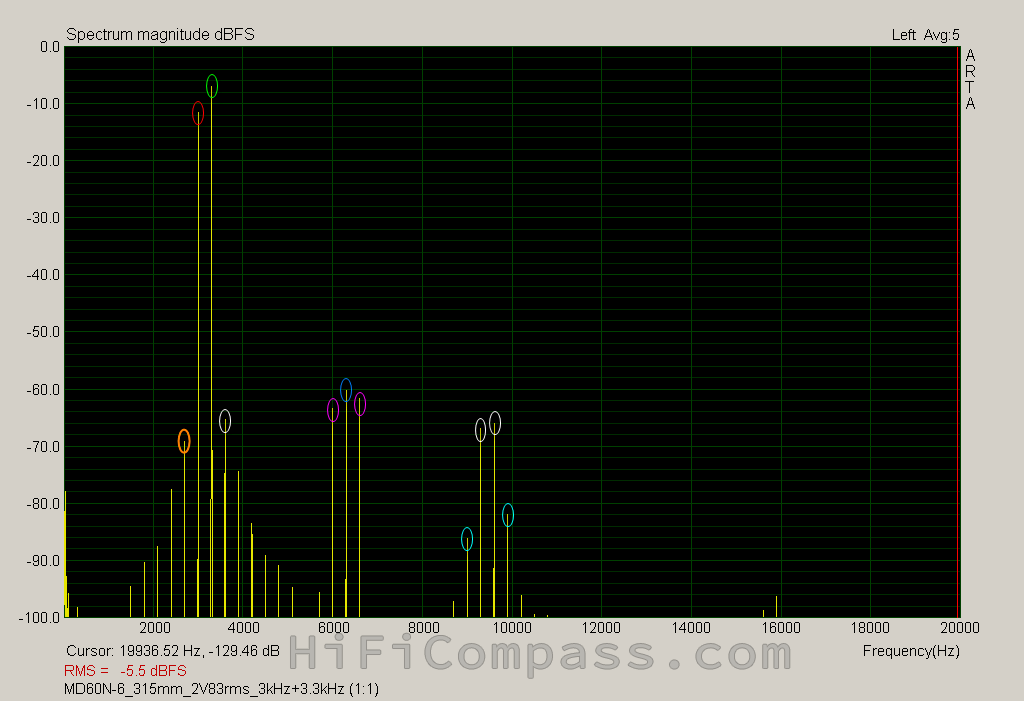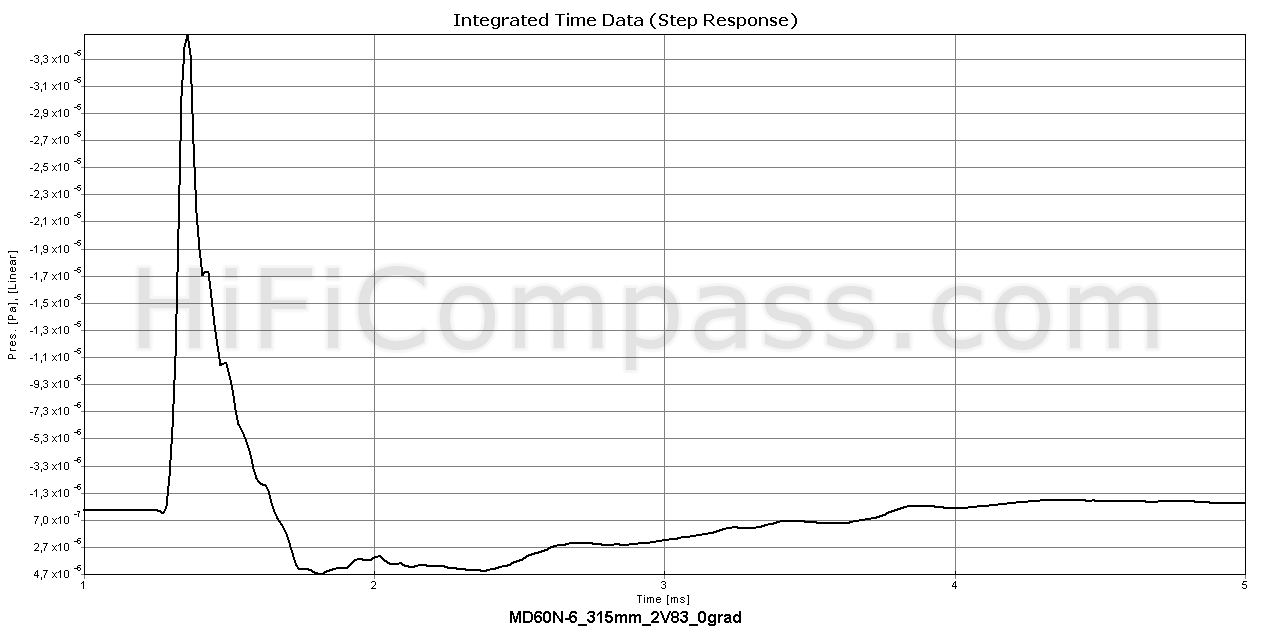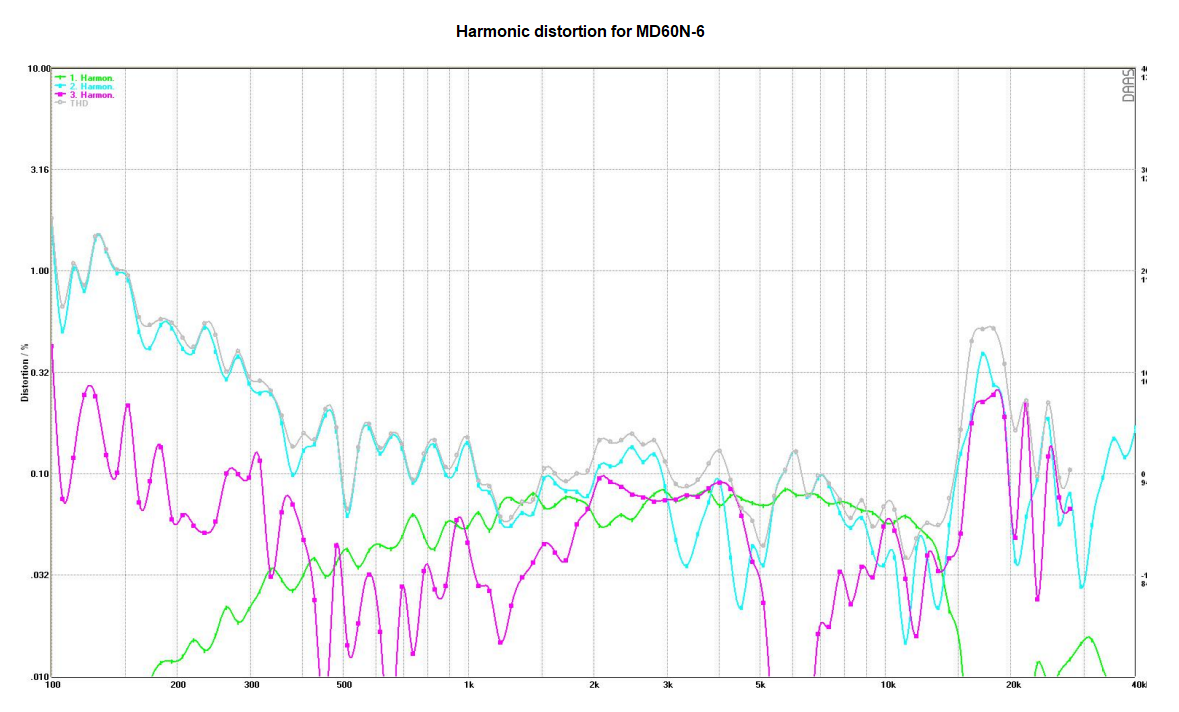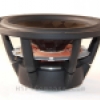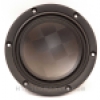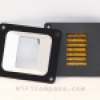HiFiCompass
Satori MD60N-6
What is on the test bench?
We continue to get acquainted with the new products of Sinar Baja Electric (Indonesia). The today's review, the second of six scheduled ones, is dedicated to the high-end 2.5" midrange fabric dome speaker Satori MD60N-6.
From the mid 70s to the late 80s of the last century, such class of speakers was very popular among European and Japanese loudspeaker manufacturers. You can find a variety of vintage loudspeakers, mostly 3-way, which used dome midranges from 2" to 3" with membranes of fabric, polymer, composite, aluminum, titanium, ceramic, beryllium, boron nitride. Those midranges covered the range from 500-800 Hz to 4-5 kHz, depending on the size of the membrane. Perhaps, the loudspeakers of this type have become an intermediate link in loudspeaker's evolution from huge boxes with short-stroke 12-15" woofers to modern much more compact ones with small-caliber long-stroke 5-8" woofers. I can't affirm, whether it was technical progress or the market stimulated its development, but the late 80s - early 90s became a turning point in the industry. With the advent of low resonant frequency tweeters, capable of operating down to 1.8-2.5 kHz, and long-stroke 6-8" woofers, slim speakers in the form of column began to come into fashion. They replaced the awkward cabinets with "golden" proportions and firmly entrenched on the market until today. Moreover, 6-8” midwoofers perform much better in the range up to 3kHz then bigger 10-15” woofers. This made it possible to successfully mate them with tweeters at frequencies in the range of 1.8-2.5 kHz. Tweeters axial output could easily match those smaller woofers and the need for an additional “filler” speaker was gone. As the result, loudspeakers have become simpler and cheaper to benefit both the manufacturer and the mass consumer. Everyone was happy, demands were driving the supplies and dome midranges continued to leave the market. Is it possible that the destiny of mammoths is waiting for them? It looks like that. Even Sinar Baja Electric (Indonesia), being one of the largest speaker manufacturers in the world (unifying SB Acoustics and Satori brands), that has produced around 175 (!) different driver models for over 13 years from subwoofers to tweeters did not have a single representative of the dome midrange family. By the way, this company is one of those, that now sets the tone for the home loudspeakers industry.
You can argue for a long time on the relevance of the concept of a loudspeaker with a dome midrange, its advantages and disadvantages, but it will always have fans and opponents. This is not the point, the fact is that the current dominating concepts of a loudspeaker with a large 6-8" midranges or midwoofers cannot provide such a wide sound dispersion, openness and liveliness of sound as a loudspeaker with a dome midrange. Therefore, the latter concept has its own, albeit a small army of fans. It is enough to mention the fact that the English company ATC has been producing its legendary 3" fabric dome midrange SM75-150(S) for 45 years and it seems it doesn't plan on stopping. Moreover, such world renowned studio monitor manufacturers as ATC, PMC, Quested, Volt, Neuman use the fabric dome midranges in their top models. They are targeting sound industry professionals and do not obey the mass market rules. That I think, says a lot and indicates that there is still a demand for dome midrange speakers.
I tried to dig up what have been produced in size 2-3" over the past 50 years. Discontinued models are marked in red. This list is not exhaustive. If you know of other models, please, write in the comments and I'll update the list:
Accuton (Germany) - C50-8-044 (2"), C51-6-286 (2"), BD51-6-585 (2")
ATC (UK) - SM75-150 (3"), SM75-150S (3")
Beyma (Spain) - MC115 (2")
Ciare (Italy) - HM500 (2"), HM600 (2")
Dayton Audio (US) - DC50FA-8 (2"), RS52AN-8 (2"), RS52FN-8 (2")
Dynaudio (Denmark) - D-52 (2"), D-52AF (2"), D-54 (2"), D-54AF (2"), D-76 (3"), D-76AF (3"), M560D (2")
Hi-Vi (China) - DMA-A (2"), DMB-A (2"), DMN-A (2")
ITT (Germany) - LPKM130-50-120TT (2")
LPG (Germany) - 50FA (2"), 51AT (2"), MCD51 (2")
Morel (Israel) - MDM55 (2"), CAM558 (2"), EM1308 (2")
Peerless (Denmark) - 821639 (2"), 821694 (2"), 821646 (2")
ScanSpeak (Denmark) - D7608/9200 (3") (former VIFA D75MX-41-08)
SEAS (Norway) - H204 (3"), 76MF H304 (3")
Tang Band (China) - 50-1426SA (2"), 75-1558SE (3")
Visaton (Germany) - G50FFL (2"), DSM50FFL (2")
Volt (UK) - VM527 (2"), VM752 (3")
as well as a number of other dome midranges manufactured by Japanese companies like Yamaha, JVC, Mitsubishi, Sony, Tonegen only for their own needs and European OEMs.
As you can see, not that much in half a century compared to thousands of other types of drivers. Considering the above, the fact that Sinar Baja Electric has decided to please fans of the concept of the "loudspeaker with a filler driver" and to add a 2.5" dome midrange to the Satori line, can't help bring anything but joy. The MD60N-6 speaker was first introduced to the world in April 2019 at AXPONA exhibition in Chicago, but its shipping started only this year.
Here you can learn about the history of the SB Acoustics and Satori brands, as well as one of the world's largest speaker drivers manufacturer - Sinar Baja Electric (www.sinarbajaelectric.com).
Why do we test this?
Sinar Baja Electric has kindly provided seven of its latest models for independent testing:
Tweeter SB Acoustics SB21SDCN-C000-4
Tweeter SB Acoustics SB21RDCN-C000-4
Tweeter Satori TW29TXN-B
Tweeter Satori TW29BNWG-4
Midrange Satori MD60N-6
Midwoofer Satori MW16TX-4
Midwoofer Satori MW19TX-4
Since all the models are just beginning to enter the market, it is impossible to find any additional information, except for meager numbers from the datasheets. Today's review opens a series of tests, the purpose of which will try to make up for the lack of information and to acquaint everyone with detailed technical characteristics and application features of the new speaker models
I would like to express my deep gratitude to Sinar Baja Electric company for the provided new products, as well as personally Mark Thomsen (International Sales & Marketing Manager SB Audience | SB Acoustics) and Melly Wulandari (SB Acoustics Project Manager) for their assistance in implementing the series of reviews.
What did the manufacturer state?
Main features noted by the manufacturer:
- Coated non-rosonant soft dome
- Powerful neodymium motor system
- Tuned closed-end transmission line chamber
- Dynamic dome stabilizer and flow resistor
- Machined aluminium faceplate
- Vented coil former
- Braided long-life silver litz wires
The third and fourth features are not so obvious, so there is a need in more thoroughly explanation of their functionality. I asked the designer Ulrik Schmidt about them:
Yevgeniy Kozhushko: Is there any secret in the back chamber construction, like Yamaha did in their NS-5000 midrange for example, or it is just a tube filled with absorption material? I think, the feature "Dynamic dome stabilizer and flow resistor" needs in the technical explanation, so that everyone could know how this works.
Ulrik Schmidt: There is no secret to the chamber, though when treated as a “correctly” damped TL, it makes it easier to handle the internal Helmholtz resonance.
The dome stabilizer/flow resistor is a relatively thick perforated dome-shaped aluminium plate sitting a couple of millimeters below the dome. On the back side, it is lined with a porous absorbent material. This makes an efficient flow resistor at the driving end of the cavity that is coupled to the TL-chamber. Being only semi-open, it slightly compresses the air behind the dome – you can think of this as a stabilizing “pillow” of air.
The metal grille also serves as an internal protection grille, preventing damage to the large dome if you try to push it in.
A bit tricky construction, isn't it?
Among the parameters, one can note the high sensitivity for this type of speakers - 94 dB / 2.83 Volt at the voice coil DC resistance of 5.3 Ohm. It seems to me that the manufacturer indicates a very conservative radiation area - 32 cm2. According to my calculations, the real value should be at least 36 cm2.
Visual inspection
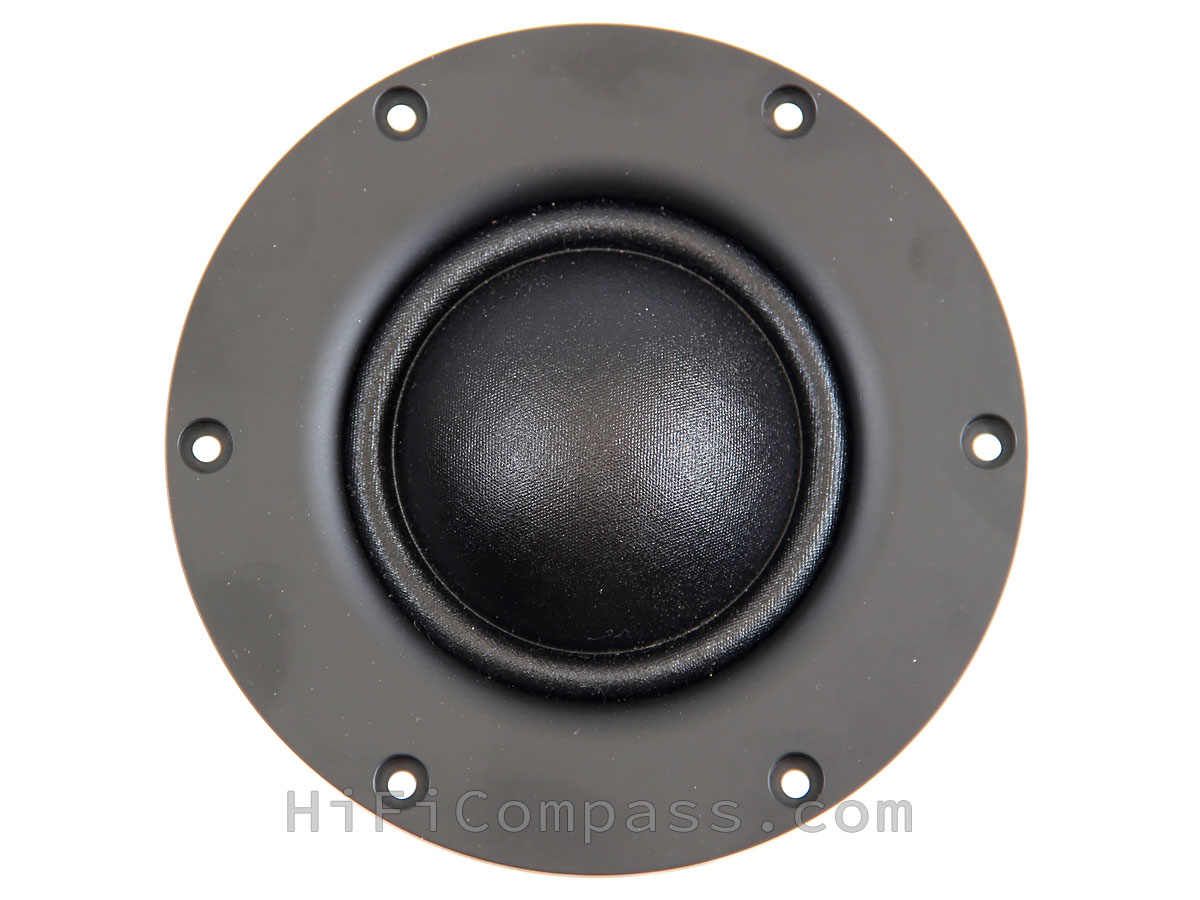 |
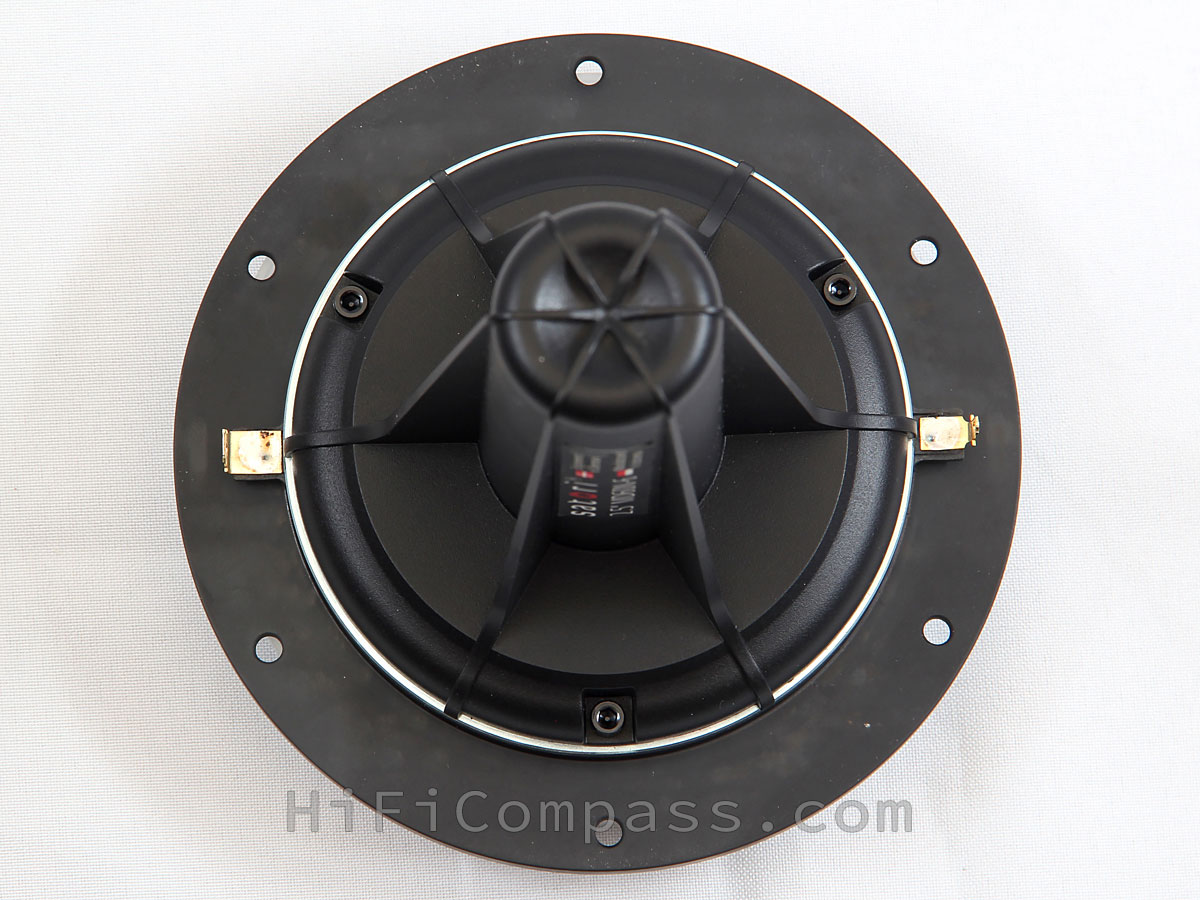 |
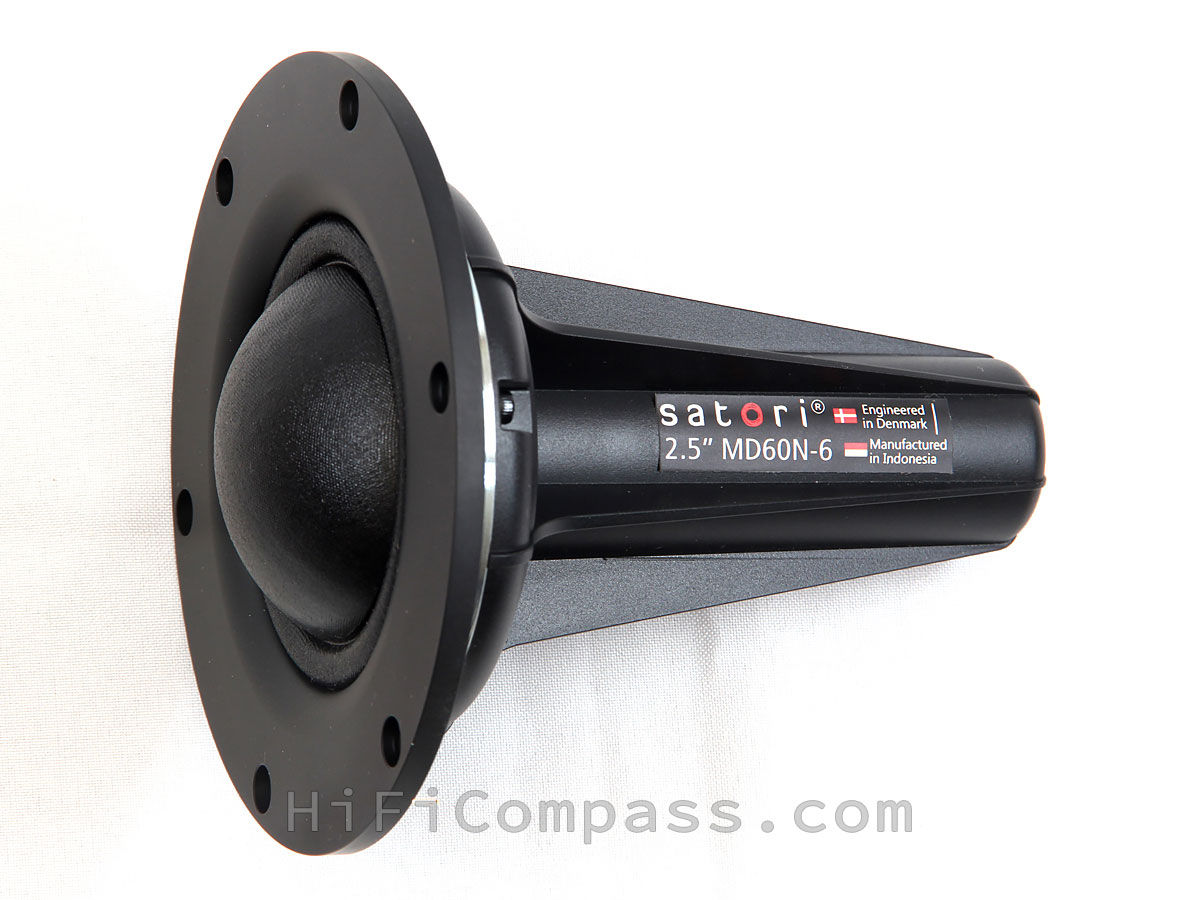 |
The MD60N-6 is supplied in a sturdy corrugated cardboard packaging. Inside there is a frame structure with special cutouts for fixing the speaker. To protect it from dust, accidental scratches and abrasions, the front of the speaker is covered with a soft, slotted cloth. Everything is simple and very reliable. The packaging is exemplary.
The dome membrane and the convex surround are made from a single piece of impregnated fabric. The fabric is non sticky to the touch, so there should be no problems with dust collection. The membrane is visually noticeably larger than its 2" competitors have.
The 5 mm thick mounting faceplate is made of aluminum and has a flawless matte powder coating that is very difficult to distinguish from anodizing. Six mounting holes with pockets for screw heads provide more than necessary clamping of the faceplate. The faceplate is attached to the speaker body with three screws from the back and can be easily removed. This gives an "advanced" user a lot of room for creative experimentation with both waveguide designs and the faceplate shapes. One might want to reduce the diameter of the faceplate to minimize the center-to-center distance with an adjacent tweeter in a loudspeaker cabinet. I don’t think it is advisable, since it's still impossible to reduce it by more than 15 mm. For a dome midrange with a 2.5" membrane, a 130mm faceplate diameter is a nice size.
I did not find an seal gasket on the back of the faceplate, although it would definitely not hurt there.
The back chamber is made of plastic in the form of a straight tube with six wedge-shaped stiffeners. It moderately responds to finger tapping. Very rigid construction. The back chamber is attached to the body with the same three screws as the faceplate and can be detached (Is it simply? Didn't try). Again, there is room for those, who think he can make the speaker better than it is.
The top plate of the motor is sandwiched between the faceplate and the back chamber. On its outer side the traces of the cutter from machining are clearly visible, which indicates the precision manufacturing of "critical" parts of the magnetic system.
The gold-plated terminals are pressed into “ears” of plastic frame, to which the moving system is attached. When connecting cable terminals to them, you need to be careful, as there is a risk of damaging these "ears". It seems to me that if the plastic "ears" for the terminals were bent back, their design would be more durable and the diameter of the faceplate could be even smaller.
Impedance frequency response
The plot shows the impedance frequency responses for two samples. Above 700 Hz the curves match very well, especially when you consider that MD60N-6 are sold separately and not as matched pairs. Below 700Hz the curves differ noticeably, apparently due to nuances of the back chamber tuning. The fact that the MD60N-6 potential operating frequency range will unlikely be below 800 Hz, such a discrepancy is not of practical concern.
From 1.5 kHz and above the impedance curves are very smooth, with no obvious traces of resonances, which indicates a well-damped moving system and internal cavities of the motor. The noticeable increase in the impedance with increasing frequency is caused by an increased inductance of the voice coil, which in turn means a copper cap absence on the pole of the magnetic system.
Below 1.5 kHz the curves begin to show a nervous character - the result of interaction of the membrane with the back chamber.
The measured resonant frequencies are 350 and 426 Hz, which is even lower than 450 Hz declared by the manufacturer. The shape of the curve below 1.5 kHz has a pronounced peak and differs from that shown in the datasheet, where it has a flat top.
On-axis frequency response
The measured sensitivity in the range from 1 to 10 kHz averaged 94 - 96 dB. The frequency response has a flat character with no tilt and extends from 800 Hz to 13 kHz. In the 3 kHz region the response does step transition from 94 to 96 dB. Below 900 Hz the response falls down with a slope of about 4 dB/octave till 300 Hz. The overall unevenness does not exceed 4 dB in the range 900 Hz - 12 kHz. There are no noticeable humps or dips in the response throughout the range, with the exception of a small swelling of about 1.5 dB at 1.5 kHz.
The frequency response does not imply any difficulties when developing a loudspeaker crossover. The responses of the two samples match almost perfectly, despite the speakers are sold separately and not as a matched pair. This match is much more difficult to achieve for large fabric domes than metal domes. Unfortunately, the measured response is quite noticeably differs from ones in the datasheet.
Off-axis frequency responses (at 315 mm)
The off-axis dispersion is typical for fabric domes of such size. It is slightly wider compared to 3" domes and slightly narrower than 2" domes do have.
I found a noticeable discrepancy between the measured and published in the datasheet off-axis responses. It seems that the manufacturer's 60-degree frequency response is more similar to that measured at 45 degrees, and the 30-degree response is more similar to that measured at 20 degrees.
Harmonic distortion (at 315 mm)
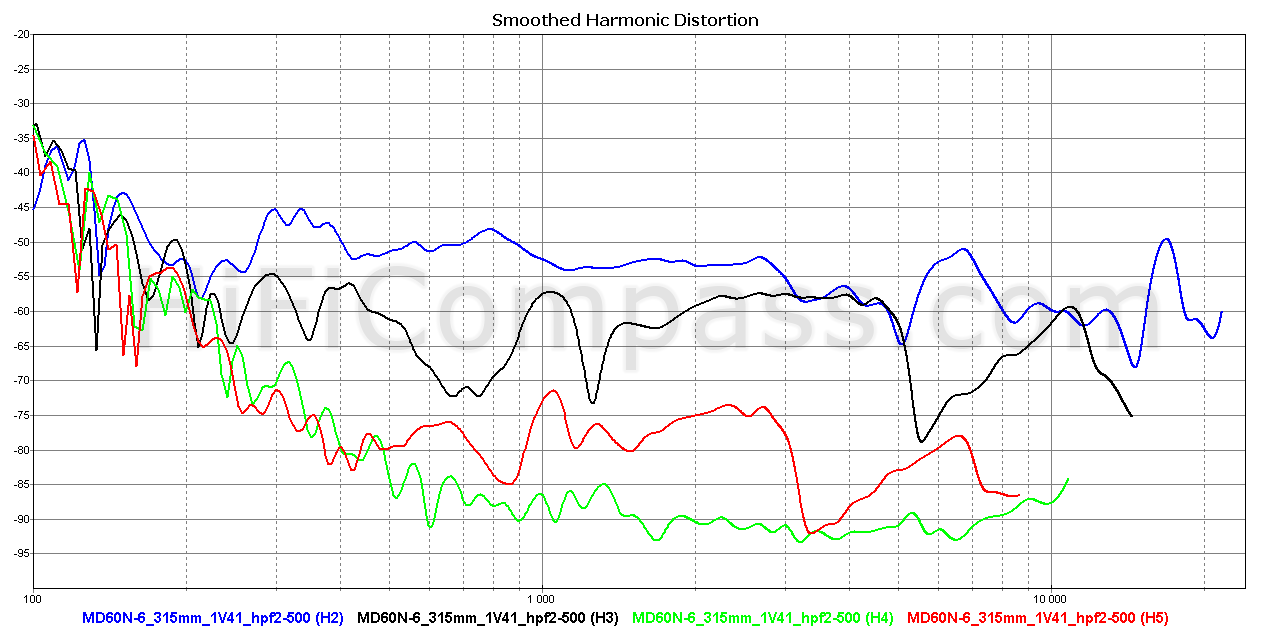 |
 |
Above are the harmonic distortions plots for the 2nd - 5th harmonics at average sound pressure levels of 89 and 107 dB (at voltages of 1.41 and 11.2 Volts respectively). To limit the speaker overload in terms of thermal power and membrane displacement when measuring harmonic distortion, a second-order Butterworth type high-pass filter with a cutoff frequency of 500 Hz was used. For those who are not very familiar with the volume levels, I note that 107 dB is very loud!
The 2nd harmonic is dominant throughout the frequency range.
Above 1.5 kHz with the level increasing from 89 to 107 dB a very insignificant increase in higher order harmonics is observed. Only the level of the 2nd harmonic grows monotonically.
Below 1.5 kHz all high order harmonics grow up with an increase in the sound pressure level and a decrease in frequency due to a sharp increase in the membrane displacement. Nevertheless, even at SPL(1 m) of 107 dB the third HD level at 1 kHz does not exceed 0.5%, the fourth - 0.056%, and the fifth - 0.2%.
Below are the distortion plots of the 2nd to 10th and separately 6th to 10th harmonics at the SPL of 107 dB . As you can see, the character is the same, no pitfalls were found. Above 1.5 kHz there are no harmonics above the 5th at all.
 |
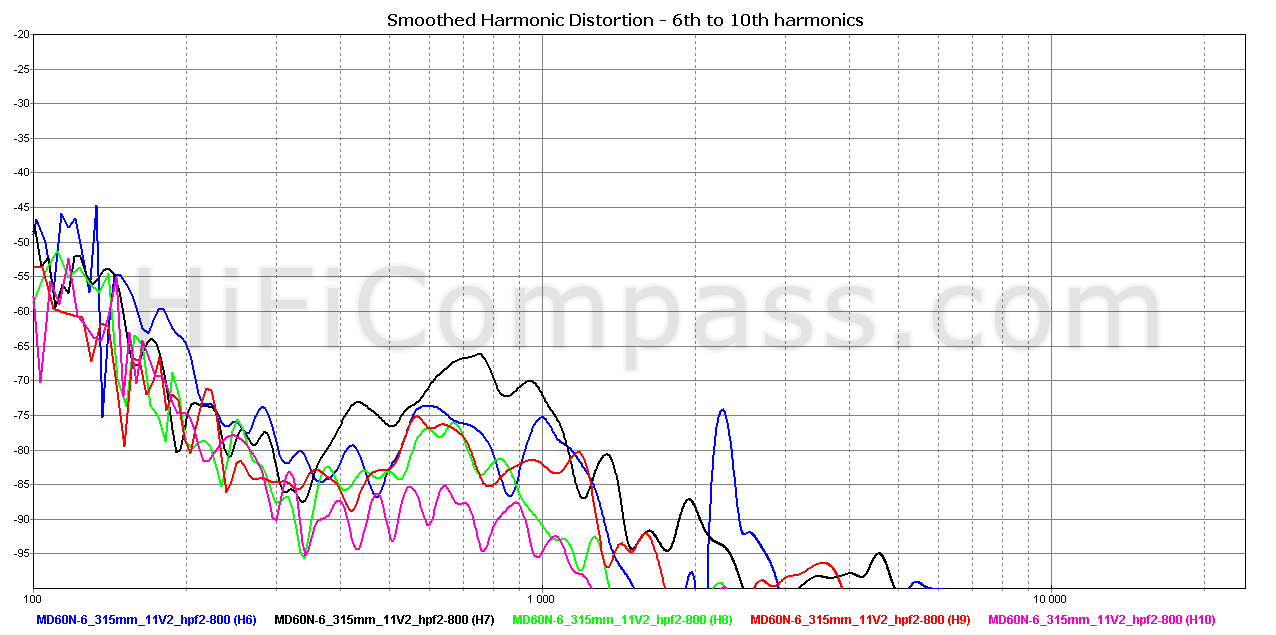 |
Now, let's observe how the harmonic's behavior changes over the entire frequency range, depending on the voltage level. Below are the graphs for the 2nd - 5th harmonics with increasing the input voltage in 3 dB steps:
 |
 |
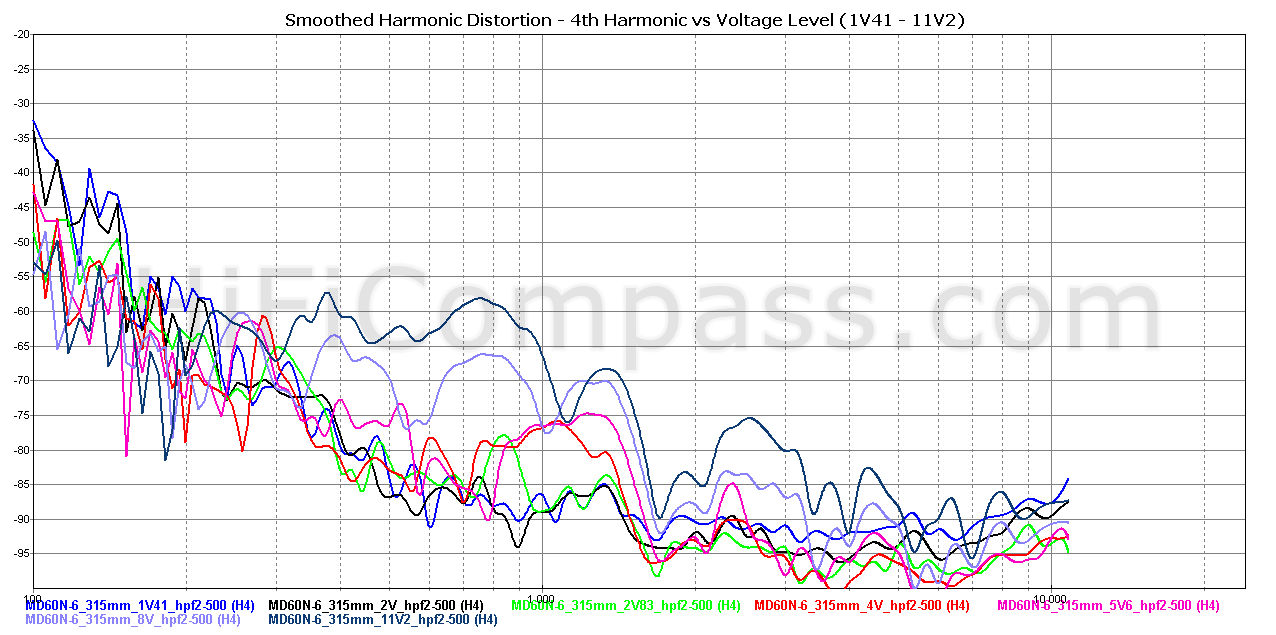 |
 |
The level of the second harmonic in the entire range increases in proportion to the input voltage and behaves in a very predictable manner. It just replicate itself at different levels.
The third harmonic barely depends on the voltage level above 1.8 kHz, and below it begins to increase with decreasing frequency and increasing the voltage. Nevertheless, its growth as it moves down in frequency does not look out of control. It reaches a maximum in the region of 900 Hz and then begins to go down. This is due to the natural decrease in SPL frequency response below 1 kHz and, accordingly, a decrease in the membrane excursion.
The 4th harmonic begins to rise below 1.6 kHz, and the 5th one below 1.3 kHz.
I would especially like to note the stable behavior of the MD60N-6 fabric membrane with increasing stress level. Fabric dome membranes often lose their rigidity and begin to "break", which manifests itself in a sharp, resonant increase in the distortion at certain frequencies. The same can't be said about the MD60N-6, up to the maximum sound pressure its distortion does not "explode anywhere".
In general, due to the high level of 2nd and 3rd harmonics, I would rate the level of harmonic distortion as "moderate". Although, if we compare the distortion at the same sound pressure, then in the frequency range above 1 kHz it is on par with one of the best 4" cone midranges today - Scan-Speak 12mu/4731T00.
Intermodulation distortion
The intermodulation distortion measurement is one of way of analyzing device non-linearity. It is not an alternative, but an additional method and allows you to identify the spectral components of the inharmonious structure, which are much more harmful for high-quality sound reproduction and to which our hearing is more sensitive.
- test frequencies
- 2nd order harmonic distortion components for the test frequencies (2nd HD)
- 3rd order harmonic distortion components for the test frequencies (3rd HD)
- 2nd order intermodulation distortion amplitude (IMA2)
- 3rd order intermodulation distortion amplitude (IMA3)
- 9th order intermodulation distortion amplitude (IMA9)
As you can see, just a couple of frequencies at the speaker terminals give rise to a whole forest of parasitic components at its output. The lower the frequency of the excitation signals, the more pronounced the speaker's nonlinearity. For example, for the pair (1kHz + 1.1kHz) the relative levels of the components IMA2=-44 dB and IMA3=-50 dB, while for (3kHz + 3.3kHz) they are respectively IMA2=-50 dB and IMA3=-56 dB... This must be taken into account when choosing the low crossover point and slope for the MD60N-6 bandpass filter.
Interestingly, when exposed to a pair of frequencies, the intermodulation components turned out to be higher than the harmonic components.
As with harmonic distortion, I would rate the intermodulation level as "moderate".
Voice coil current harmonic distortion
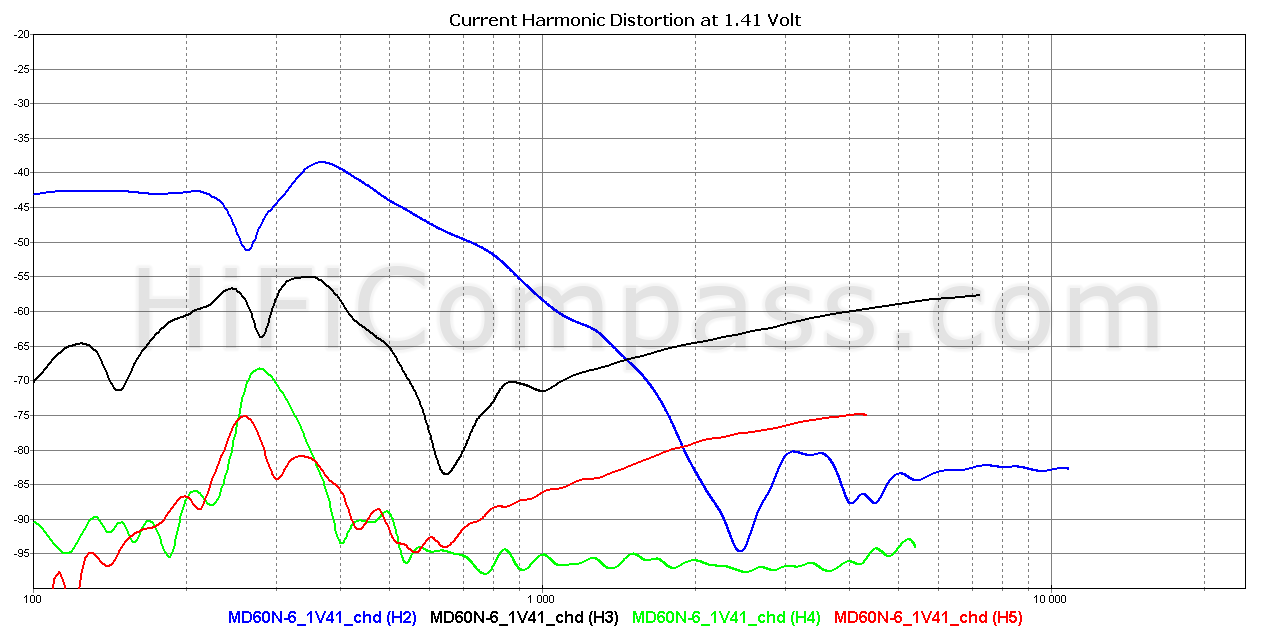 |
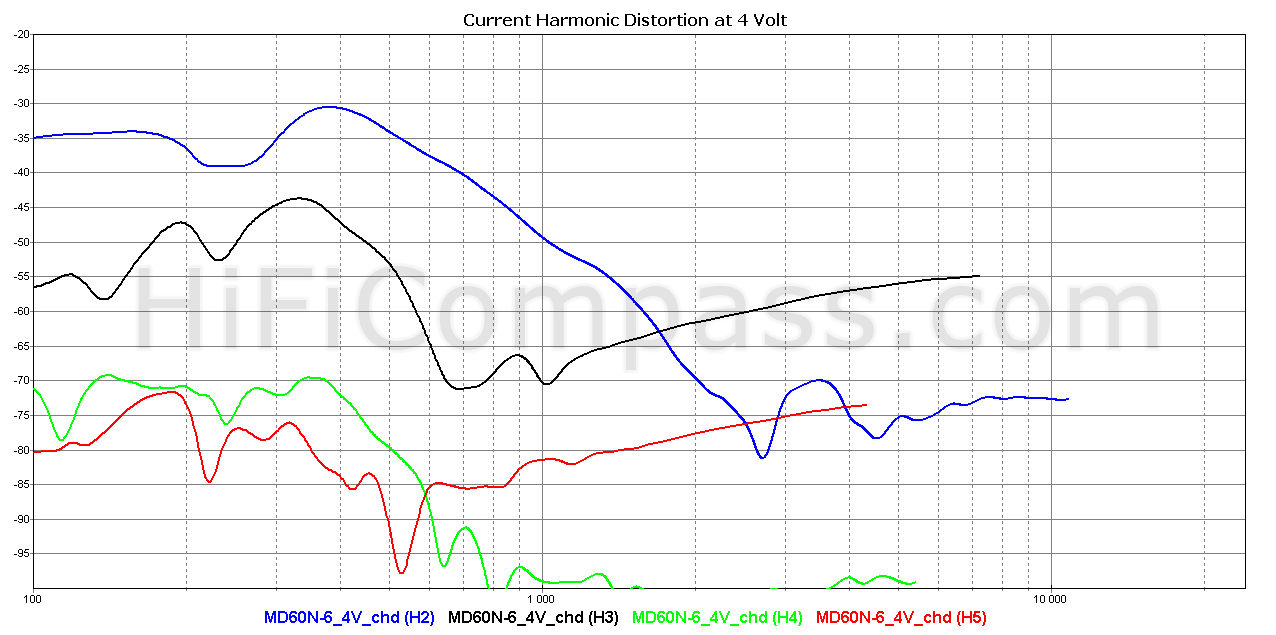 |
This type of measurement, despite its simplicity, is an excellent tool for assessing the linearity of a speaker motor. The above plots show the frequency dependences of the 2nd, 3rd, 4th and 5th harmonics of the voice coil current at 1.41 and 4 Volt.
Voice coil current nonlinearity is the direct nonlinearity of the mechanical force driving the speaker cone, since this force is related to the current by a simple relationship F=B*L*I, where B is the magnetic field strength, L is the length of the voice coil wire inside the magnetic gap and I is the current. So, in principle, it is practically impossible to obtain sound pressure distortion lower than current distortion in the frequency range where the contribution of the motional nonlinearity becomes insignificant.
The fourth harmonic is so small that it doesn't even need to be taken into account. The behavior of the third and fifth harmonics also weakly depends on the voltage level and is similar to their behavior in terms of sound pressure.
The second harmonic of the current also linearly depends on the voltage level, like the second harmonic of the sound pressure, however, its level is 5-30 dB lower. This suggests that its main source could be an asymmetry of the suspension or the motor's BL(x) curve.
Step response
The step responses demonstrate excellent slew rate and fast decay. It's almost perfect, one might say. If it weren't for the small ripples in the response on its way to a steady state, the word "almost" could be completely omitted. These ripples appears to be an echo of the small hump in the frequency response at 1.5 kHz. Very well balanced moving system.
Waterfall
The waterfall shows the same effects as a step response, in addition exposing hidden resonances that are difficult to see in other types of measurements.
As you can see, there is a small "tail" at 1.5 kHz. Otherwise, everything is fine, the moving system calms down very quickly.
The ridges in the 2 - 5 kHz region are not related to the speaker. They are caused by reflections fromthe test baffle edges and they appear in most of my measurements.
Listening impressions
And the MD60N-6 sounds very good for my taste. Suffice it to say that I first heard it as part of the Menara demo speaker in the SB Acoustics booth at HighEnd-2019 in Munich and was so impressed, that presented the developers (Ulrik Schmidt) with an award certificate for the best 3-way speaker system. You can read more about it here.
The complete dominance of the second harmonic in the distortion profile of the MD60N-6 gives the sound its characteristic signature - roundness, relief, fleshiness, volume, softness and warmth. The sound images that this midrange draws are slightly forward, closer to the listener than they are somewhere inside or behind the loudspeaker cabinet. I wouldn't call it very detailed or transparent, sharp or cold. He certainly does not suffer from dryness or analyticism. It does not pretend on absolutely accurate and flawless sound reproduction, but it can please with harmonious and emotional performance, creating a tangible effect of involvement.
I did try a bit torture the MD60N-6 in a test baffle, filtered it with a 2nd and even 1st order high-pass filter at 800 Hz. The torture was quite hard, but at peak voltage levels reaching 25 (!) Volts and a very uncomfortable volume level for listening nothing catastrophic was noticed. The nonlinearity of human hearing at such volume levels can bring a lot of distortion, which obstructs to assess the distortion of the speaker itself.
"How to use" recomendations
The MD60N-6 was born for 3 - 4 way loudspeakers to be doing as a so-called "filler" speaker, filling the gap in the mid range that is poorly covered by large cone midrange speakers. Menara loudspeaker is a great example of how the MD60N-6 should be used. A conservative approach when deciding on its operating frequency range is from 1 to 4 kHz, but judging from its nonlinear distortions this range can be extended to 800 Hz - 6 kHz.
What is the price and where to purchase it?
The MD60N-6 are already ready to order. The retail price is €138-149 per piece excluding VAT. It can be purchased in the following online stores:
- https://solen.ca/products/speakers/home-speakers/midranges/sb-acoustics-...
- https://www.madisoundspeakerstore.com/approx-2-fullrange/satori-md60n-6-...
- https://www.audiohobby.eu/ru/sb-acoustics-tweeters-satori/15122-sb-acous...
- https://audio-hi.fi/ru/sb_acoustics_md60n-6_2973-p-5007.html
Summary
The testing revealed some discrepancy between the published in the datasheet and the measured axial and off-axis frequency responses, the impedance response below 1.5 kHz. It possible, this is due to the fact that the datasheet is provide for a speaker prototype, and the testing was carried out for a production model, in which some changes may have been made. Nevertheless, everyone would like to have an updated datasheet, which matches the production model, because the MD60N-6, after all, belongs to the top speaker line (Satori).
Harmonic distortion measurements have not impressed us with record low values that Satori brand have spoiled us in the past. It's Satori's own fault that it has raised the bar of technical excellence too high until now, when the background of the vast majority of speakers from other manufacturers look very pale. In fact, the distortions of the MD60N-6 is not worse than those of the very popular and more expensive "high-end" competitors: Scan-Speak 15M/4531K00, Scan-Speak 12M/4631G00, Scan-Speak 12mu/4731T00, SEAS M15CH002, Accuton C50-8-044, Accuton C173-6-090.
Let's remember, that the speaker and its characteristics turned out to be what they are, not because SB couldn't do any better, but because that is how the driver was designed and conceived. . This can be confirmed by the words of the designer Ulrik Schmidt (Danesian Audio) from our correspondence:
Yevgeniy Kozhushko: Ulrik, the MD60N-6 has a mediocre nonlinear distortion measurements. Despite that I like how it sounds and am very glad that such a midrange has appeared on the market. Personally, I think the people often overestimate their ability to hear nonlinear distortion and give them too much significance. Some people make their decision on selecting speakers for a loudspeaker project relying on only on their nonlinear distortion profile. For me the sound signature of speaker membrane material is no less important. SB Acoustics positions this midrange as their top line product and I feel the coming DIY community speculations regarding the MD60N-6 distortion. Could you explain why you decided not to give to the MD60N-6 such a good motor as in all other speakers of Satori family?
Ulrik Schmidt: Hi Yevgeniy, please find attached our distortion measurement for the MD60N-6 (this is for the average/representative driver from the pilot run, which was chosen as production the reference driver). I find this to be pretty decent and a fairly low level in the entire usable range.
I never use distortion measurements as part of the development process (if you do things right, fundamentally, distortion figures will also be fine). We do it for documentation, of course – and on request.
The MD60N-6 is in a Satori price range, hence it is a Satori driver. This is a filler driver and we didn’t feel the need for a copper cap to lift the upper end (this would only reduce BL, as the air gap would have to be slightly wider). We could easily sacrifice a little sensitivity, of course, but in this case I preferred to optimize the BL-to-Mms ratio. Besides the lack of a copper cap, it is a fully optimized motor system with all machined parts (like our other Satori motors) and it is inherently under-cut, as the pole plate extends beyond the powerful center neodymium ring magnet (which behaves virtually like air to the voice coil).
Summarizing the above, I can highlight the following:
- high sensitivity - from 94 to 96 dB/2.83 Volt*1 m
- extended and even SPL frequency response
- moderate nonlinear distortion
- can be used in the range of 800 Hz to 6 kHz
- you need to be careful with graphs from the prototype's datasheet
- excellent workmanship
- compact size
- very good consistancy
You can get more information about the measurement results here
Yevgeniy Kozhushko/21.12.2020
CONTACTS
- Ukraine
- (+380) 95 904 7827
- hificompass@gmail.com
LAST NEWS
-
04 Mar 2025
-
25 Feb 2025
-
10 Feb 2025
-
01 Feb 2025

